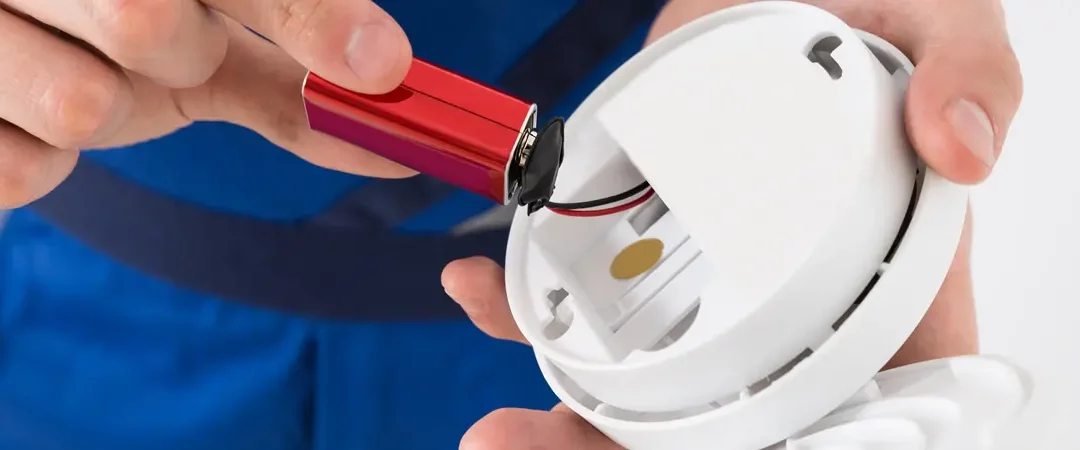An interesting read about “Smoke Detector vs. Carbon Monoxide Detector” from “Home Care Buzz”.
There is nothing quite as startling as the shrill beeping of a smoke detector suddenly sounding the alarm. If you’ve ever had a malfunctioning detector, you’ve likely wanted to rip it off the ceiling or pull out the battery just to make it stop. Smoke detectors, however, are important for the safety of your home and loved ones. So even if the loud noise you hear emanating from a smoke alarm is not to warn you of a potential fire, it is likely to alert you that it is time to maintain or replace it.
Smoke detectors and carbon monoxide detectors are great set-it-and-forget-it safety features in a home, but they still wear down with time. If either of these devices is old or malfunctioning, it’s time to replace or upgrade the units.
The following guide will show you the different types of alarms you can choose from, and lay out some easy steps to install them properly.
Smoke Detector vs. Carbon Monoxide Detector vs. Smoke and Carbon Monoxide Detector
Smoke Detectors
Essentially, this type of detector senses when there’s smoke or other small particles (like steam) in the air. So, if there’s any type of combustion going on, whether it’s smoke from the oven or a lit candle that managed to burn the curtains, this device will alert everyone around.Smoke detector.
When you shop for a new detector, you will see three types of alarms. This is because fires burn differently: some flare and some smolder. Ionization smoke detectors best detect quick-to-start flaming fires but tend to sound a false alarm with basic cooking smoke. Photoelectric smoke detectors are less prone to false alarms and sniff out the smoldering, smokey fires best.
Even with safety as the ultimate consideration, no one wants to install two different detectors in every room. Luckily, dual-sensor alarms are effective at detecting both types of fire. They use both ionization and photoelectric technology to detect a range of fires and smoke.
Smoke alarms also come specifically designed for different areas of your home. Bedroom alarms come with a 10-year lithium-ion battery to prevent a low-battery beep from waking you up at night. Bedroom detectors also have a voice-alert feature, which starts soft and then grows louder to wake you without startling you. Also, kitchen smoke detectors come as a smoke and carbon monoxide detector combo designed to detect real fires faster, detect carbon monoxide, and trigger fewer false alarms.
Carbon Monoxide Detectors
Carbon monoxide (CO) detectors are less complicated than smoke detectors. Carbon monoxide detectors will sense the presence of carbon monoxide in your home and sound an alarm. Most of these detectors work the same way and use a similar sensor across models and brands. The main difference between carbon monoxide detectors is how they are powered: battery, hardwired, or plug-in. The battery-operated alarms usually have a ten-year lifespan to help prevent you from needing to change the battery frequently. The plug-in alarms simply plug into an outlet and some also have a battery backup in case of a power outage.
Some carbon monoxide detectors models include backlit digital LED displays with an easy-to-read screen that shows the temperature and the carbon monoxide concentration levels when detected.
Quick tip: Remember, carbon monoxide detectors do not detect smoke or explosive gases, such as natural gas, propane, and methane.
Smoke and Carbon Monoxide Detector Combo
Much like the dual-sensor smoke detectors, smoke and carbon monoxide detectors use both ionization and photoelectric technology along with carbon monoxide detection. There are also smart smoke detectors, like the Nest smoke detectors that are becoming more popular. These types of smart smoke detectors come packed with features including smartphone alerts for low batteries and detection of carbon monoxide (CO) or smoke, and a “silent” button from your phone.
Hardwired vs. Battery (Standalone)
Smoke and carbon monoxide detectors, especially the battery-powered versions, can be installed quite easily without the help of a professional.
A hardwired smoke detector is connected directly to your home’s electrical system. This type of detector also includes a battery backup to keep it functioning during power outages. Hardwired detectors are standard in new home construction.
Battery-powered detectors are standalone and don’t require electrical wiring. Either a 9-volt or AA battery is all the power the alarm needs. Many new models use lithium batteries which can last up to 10 years and save you from changing the battery several times a year (you should still test them monthly, however).
Plug-in carbon monoxide detectors plug directly into an electrical wall outlet. The plug-in design isn’t practical for smoke alarms but works for carbon monoxide alarms.
Where to Place Your Smoke and Carbon Detectors
When you install a smoke detector, it must be installed in the proper locations in your home. The kitchen, laundry room, bedrooms, hallways, and living room are the common areas you want to place alarms—no need to overdo it with too many in one area though. Space them out well enough so they can be heard when an alarm goes off in another area of the house.
The best position for your alarms is on the ceiling, as smoke and gas rise. Directly in the center of the room is perfect, but if that position is not possible, make sure your alarm is at least four inches from the wall.
If you must place detectors on a wall, place them at least four inches from the ceiling and wall corners. Detectors need as much space around them as possible to better sense smoke. Do not position detectors over stove-tops, ovens, clothes dryers, or other areas where there’s a significant chance of triggering false alarms.


